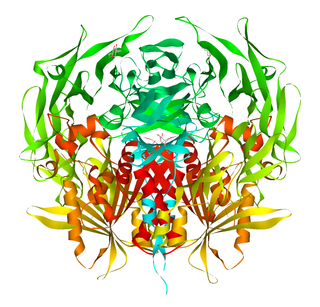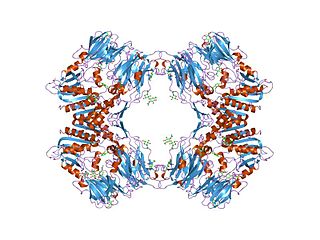Related Research Articles

Vildagliptin, sold under the brand name Galvus and others, is an oral anti-hyperglycemic agent of the dipeptidyl peptidase-4 (DPP-4) inhibitor class of drugs. Vildagliptin inhibits the inactivation of GLP-1 and GIP by DPP-4, allowing GLP-1 and GIP to potentiate the secretion of insulin in the beta cells and suppress glucagon release by the alpha cells of the islets of Langerhans in the pancreas.

Inhibitors of dipeptidyl peptidase 4 are a class of oral hypoglycemics that block the enzyme dipeptidyl peptidase-4 (DPP-4). They can be used to treat diabetes mellitus type 2.

Dipeptidyl peptidase-4, also known as adenosine deaminase complexing protein 2 or CD26 is a protein that, in humans, is encoded by the DPP4 gene. DPP4 is related to FAP, DPP8, and DPP9. The enzyme was discovered in 1966 by Hopsu-Havu and Glenner, and as a result of various studies on chemism, was called dipeptidyl peptidase IV [DP IV].

Saxagliptin, sold under the brand name Onglyza, is an oral hypoglycemic of the dipeptidyl peptidase-4 (DPP-4) inhibitor class. Early development was solely by Bristol-Myers Squibb; in 2007 AstraZeneca joined with Bristol-Myers Squibb to co-develop the final compound and collaborate on the marketing of the drug.

Dipeptidyl-peptidase 3 is an enzyme that in humans is encoded by the DPP3 gene.

Inactive dipeptidyl peptidase 10 is a protein that in humans is encoded by the DPP10 gene. Alternate transcriptional splice variants, encoding different isoforms, have been characterized.

Dipeptidyl peptidase 9 is an enzyme that in humans is encoded by the DPP9 gene.
Dipeptidyl peptidase-4 inhibitors are enzyme inhibitors that inhibit the enzyme dipeptidyl peptidase-4 (DPP-4). They are used in the treatment of type 2 diabetes mellitus. Inhibition of the DPP-4 enzyme prolongs and enhances the activity of incretins that play an important role in insulin secretion and blood glucose control regulation. Type 2 diabetes mellitus is a chronic metabolic disease that results from inability of the β-cells in the pancreas to secrete sufficient amounts of insulin to meet the body's needs. Insulin resistance and increased hepatic glucose production can also play a role by increasing the body's demand for insulin. Current treatments, other than insulin supplementation, are sometimes not sufficient to achieve control and may cause undesirable side effects, such as weight gain and hypoglycemia. In recent years, new drugs have been developed, based on continuing research into the mechanism of insulin production and regulation of the metabolism of sugar in the body. The enzyme DPP-4 has been found to play a significant role.

Dipeptidyl peptidase I is an enzyme. This enzyme catalyses the following chemical reaction
A tripeptidyl peptidase is a type of enzyme.

In molecular biology, the dipeptidyl-peptidase IV family is a family of serine peptidases which belong to MEROPS peptidase family S9, subfamily S9B. The protein fold of the peptidase domain for members of this family resembles that of serine carboxypeptidase D, the type example of clan SC. The type example of this family is Dipeptidyl peptidase-4.
Dipeptidyl-peptidase III is an enzyme. This enzyme catalyses the following chemical reaction

Gemigliptin (rINN), sold under the brand name Zemiglo, is an oral anti-hyperglycemic agent of the dipeptidyl peptidase-4 inhibitor class of drugs. Glucose lowering effects of DPP-4 inhibitors are mainly mediated by GLP-1 and gastric inhibitory polypeptide (GIP) incretin hormones which are inactivated by DPP-4.
Dipeptidyl-peptidase II is an enzyme. This enzyme catalyses the following chemical reaction:
Xaa-Pro dipeptidyl-peptidase (EC 3.4.14.11, X-prolyl dipeptidyl aminopeptidase, PepX, X-prolyl dipeptidyl peptidase is an enzyme. It catalyses the following chemical reaction

Teneligliptin is a pharmaceutical drug for the treatment of type 2 diabetes mellitus. It belongs to the class of anti-diabetic drugs known as dipeptidyl peptidase-4 inhibitors or "gliptins".

Trelagliptin is a pharmaceutical drug used for the treatment of type 2 diabetes.

Omarigliptin (MK-3102) is a potent, long-acting oral antidiabetic drug of the DPP-4 inhibitor class used for once-weekly treatment of type 2 diabetes and currently under development by Merck & Co. It inhibits DPP-4 to increase incretin levels, which inhibit glucagon release, which in turn increases insulin secretion, decreases gastric emptying and decreases blood glucose levels.

Evogliptin is an antidiabetic drug in the dipeptidyl peptidase-4 (DPP-4) inhibitor or "gliptin" class of drugs. It was developed by the South Korean pharmaceutical company Dong-A ST and is approved for use in South Korea and Russia. In a meta-analysis involving data from 6 randomized controlled trials, Dutta et. al. demonstrated the good glycaemic efficacy and safety of this medicine as compared to other DPP4 inhibitors like sitagliptin and linagliptin.

Gosogliptin is a drug for the treatment of type II diabetes. It is in the class of dipeptidyl peptidase-4 (DPP-4) inhibitors. It was discovered and developed through Phase 1 and Phase 2 by Pfizer. The crystal structure of DPP-4 in complex with gosogliptin is available. Its metabolism, excretion and pharmacokinetics in rat, dog and human have been described. A cost efficient route has been published. Other studies including Phase 3 studies were conducted in Russia. It is approved for use in Russia.
References
- ↑ Dipeptidyl+Peptidases at the U.S. National Library of Medicine Medical Subject Headings (MeSH)